ECU CITROEN C4 2018 Owners Manual
[x] Cancel search | Manufacturer: CITROEN, Model Year: 2018, Model line: C4, Model: CITROEN C4 2018Pages: 317, PDF Size: 9.31 MB
Page 7 of 317
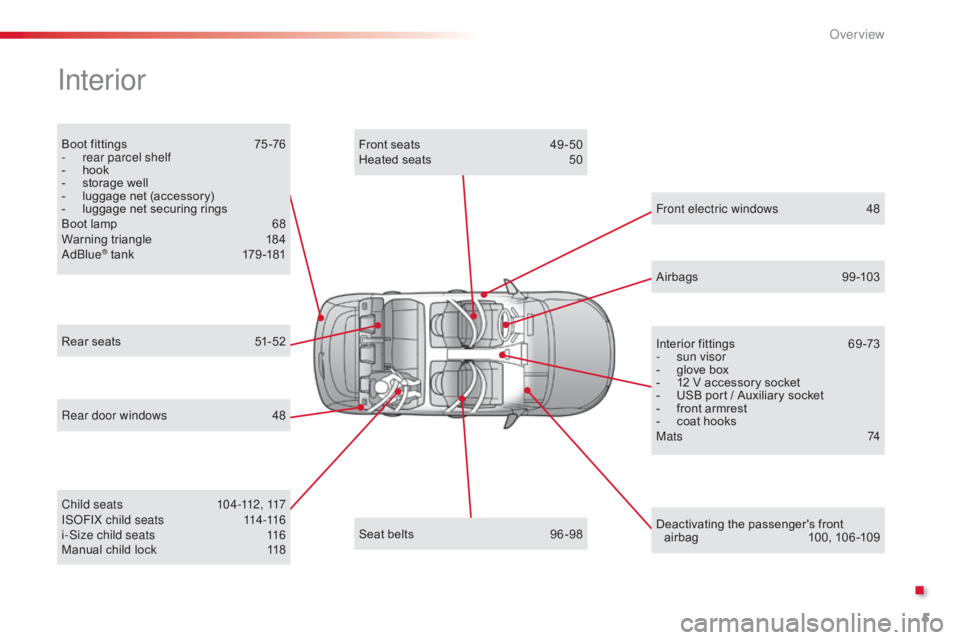
5
C4-cactus_en_Chap00b_vue-ensemble_ed01-2016
Boot fittings 75 -76
- r ear parcel shelf
-
h
ook
-
s
torage well
-
l
uggage net (accessory)
-
l
uggage net securing rings
Boot
lamp
6
8
Warning
triangle
1
84
AdBlue
® t a n k 17 9 -181
Interior
Rear door windows 4 8
Manual child lock
1
18
Rear
seats
5
1-52
Airbags
9
9-103
Front electric windows
4
8
Deactivating
t
he
p
assenger's
f
ront
a
irbag
10
0,
10
6 -109
Seat
belts
9
6 -98
Child seats
1
04-112, 117
ISOFIX child seats
1
14-116
i-Size child seats
1
16Front
seats
4
9 -50
Heated seats
5
0
Interior fittings
6
9 -73
-
s
un visor
-
g
love box
-
1
2 V accessory socket
-
U
SB port / Auxiliary socket
- f ront armrest
- c oat hooks
M a t s
74
.
Over view
Page 46 of 317
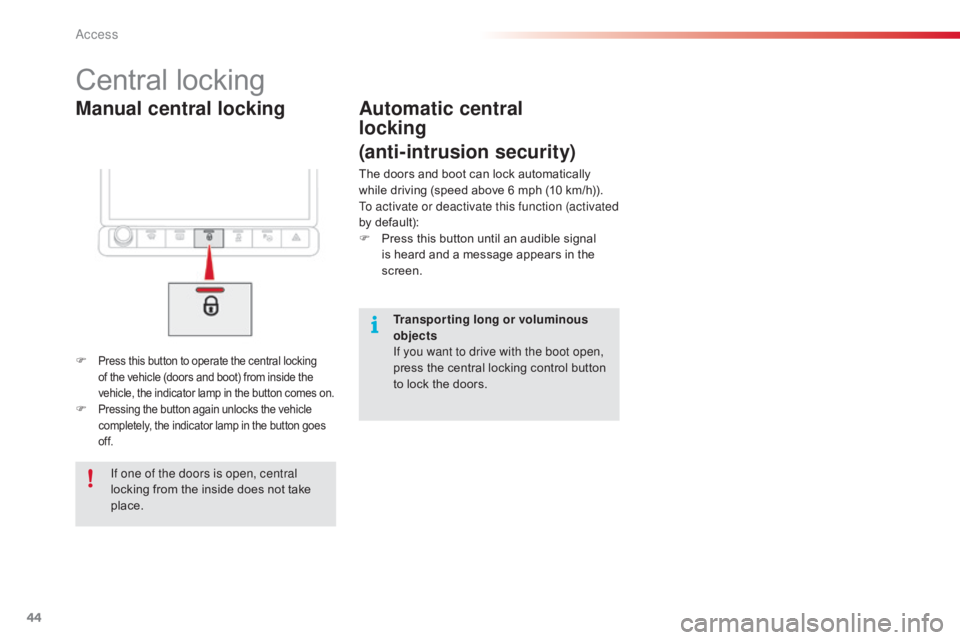
44
C4-cactus_en_Chap02_ouvertures_ed01-2016
Manual central locking
Central locking
F Press this button to operate the central locking of the vehicle (doors and boot) from inside the v
ehicle, the indicator lamp in the button comes on.
F Pressing the button again unlocks the vehicle c
ompletely, the indicator lamp in the button goes o
f f.
Automatic central
locking
(anti-intrusion security)
The doors and boot can lock automatically while driving (speed above 6 mph (10 km/h)).
To activate or deactivate this function (activated
by
default):
F
P
ress this button until an audible signal
i
s heard and a message appears in the
sc
reen.
If one of the doors is open, central
locking
from
the
inside
does
not
take
p
lace. Transporting long or voluminous
objects
If you want to drive with the boot open,
press
the central locking control button
t
o lock the doors.
Access
Page 50 of 317
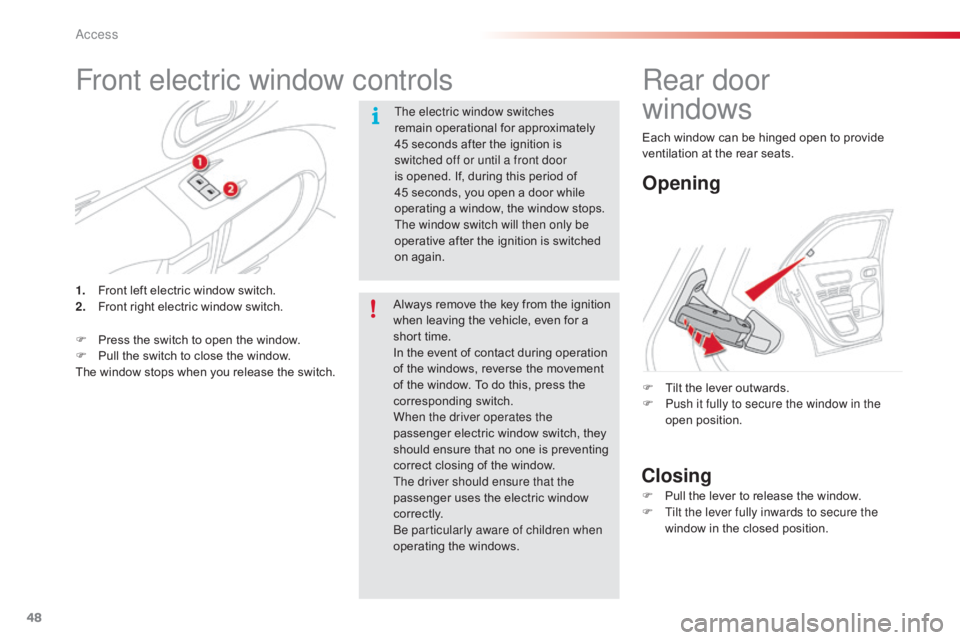
48
C4-cactus_en_Chap02_ouvertures_ed01-2016
Front electric window controls
The electric window switches
remain operational for approximately
4
5 seconds after the ignition is
s
witched off or until a front door
is
opened. If, during this period of
4
5 seconds, you open a door while
o
perating a window, the window stops.
T
he window switch will then only be
operative
after the ignition is switched
o
n again.
1.
F
ront
left
electric
window
switch.
2.
F
ront
right
electric
window
switch.
F
P
ress
the
switch
to
open
the
window.
F
P
ull
the
switch
to
close
the
window.
The
window
stops
when
you
release
the
switch. Always
remove the key from the ignition
w
hen leaving the vehicle, even for a
s
hort time.
In
the event of contact during operation
o
f the windows, reverse the movement
o
f the window. To do this, press the
c
orresponding
s
witch.
When the driver operates the
passenger
electric window switch, they
s
hould ensure that no one is preventing
c
orrect closing of the window.
The driver should ensure that the
passenger
uses the electric window
c
o r r e c t l y.
Be particularly aware of children when
operating
t
he
w
indows.
Rear door
windows
Opening
Closing
F Tilt the lever outwards.
F P ush it fully to secure the window in the
open
p
osition.
F
P
ull the lever to release the window.
F
T
ilt the lever fully inwards to secure the
window
in the closed position.
Each
window can be hinged open to provide
v
entilation at the rear seats.
Access
Page 54 of 317
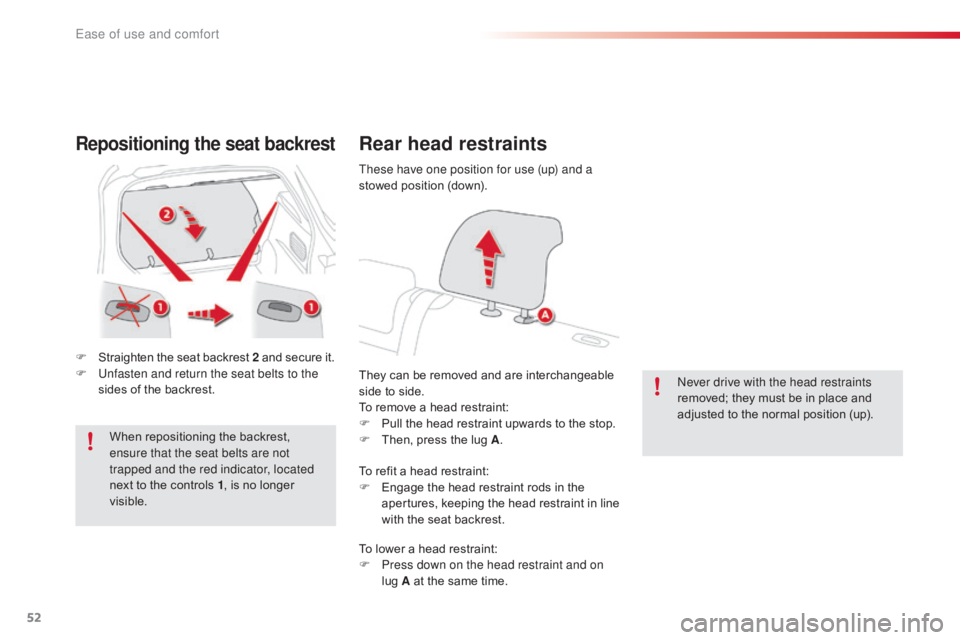
52
C4-cactus_en_Chap03_Ergonomie-et-confort_ed01-2016
Repositioning the seat backrest
F Straighten the seat backrest 2 and secure it.
F U nfasten and return the seat belts to the
sides
of the backrest.
When
repositioning the backrest,
e
nsure that the seat belts are not
trapped and the red indicator, located
next
to the controls 1,
is no longer
vis
ible.
Rear head restraints
They can be removed and are interchangeable side to side.
To
remove a head restraint:
F
P
ull the head restraint upwards to the stop.
F
T
hen, press the lug A. Never drive with the head restraints
removed;
they must be in place and
a
djusted to the normal position (up).
These have one position for use (up) and a
stowed
position (down).
To refit a head restraint:
F
E
ngage the head restraint rods in the
a
pertures,
k
eeping
t
he
h
ead
r
estraint
i
n
l
ine
w
ith the seat backrest.
To
lower a head restraint:
F
P
ress down on the head restraint and on
lug
A at the same time.
Ease of use and comfort
Page 76 of 317
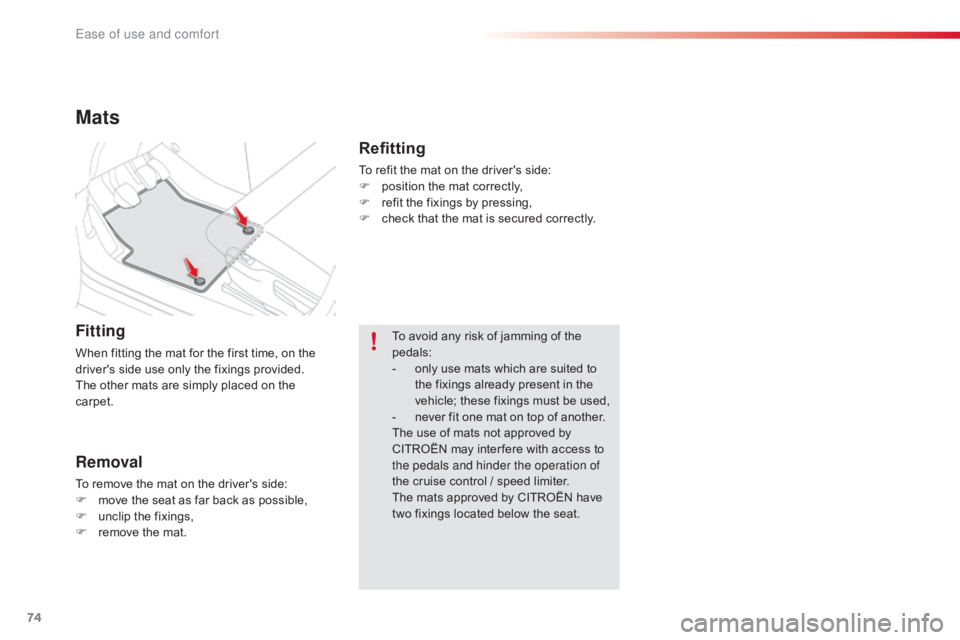
74
C4-cactus_en_Chap03_Ergonomie-et-confort_ed01-2016
Mats
Fitting
When fitting the mat for the first time, on the driver's side use only the fixings provided.
The
other mats are simply placed on the
c
arpet.
Removal
To remove the mat on the driver's side:
F m ove the seat as far back as possible,
F
u
nclip the fixings,
F
r
emove the mat. To
avoid any risk of jamming of the
ped
als:
-
o
nly use mats which are suited to
t
he fixings already present in the
v
ehicle; these fixings must be used,
-
n
ever fit one mat on top of another.
The use of mats not approved by
C
ITROËN may inter fere with access to
t
he pedals and hinder the operation of
the cruise control / speed limiter.
The mats approved by CITROËN have
t
wo fixings located below the seat.
Refitting
To refit the mat on the driver's side:
F p osition the mat correctly,
F
r
efit the fixings by pressing,
F
c
heck that the mat is secured correctly.
Ease of use and comfort
Page 77 of 317

75
C4-cactus_en_Chap03_Ergonomie-et-confort_ed01-2016
Boot fittings
1. Rear parcel shelf.
2. H ook.
3.
St
orage
b
ox.
4.
S
torage net (accessory).
5.
S
torage net fixing rings.
The
storage net fixing rings are not
i
ntended to secure loads or restrain
baggage.
3
Ease of use and comfort
Page 78 of 317
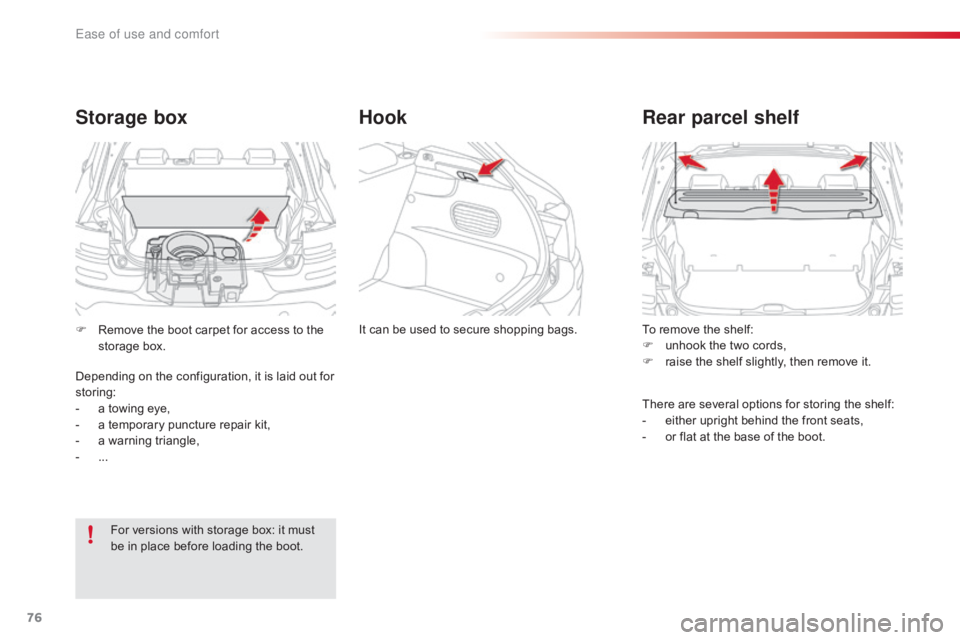
76
C4-cactus_en_Chap03_Ergonomie-et-confort_ed01-2016
To remove the shelf:
F u nhook the two cords,
F
r
aise the shelf slightly, then remove it.
Rear parcel shelf
There are several options for storing the shelf:
- e ither upright behind the front seats,
-
o
r flat at the base of the boot.
It
can
be
used
to
secure
shopping
bags.
Hook
Storage box
For versions with storage box: it must b
e in place before loading the boot.
F
R
emove the boot carpet for access to the
s
torage box.
Depending on the configuration, it is laid out for
s
toring:
-
a
towing eye,
-
a
temporary puncture repair kit,
-
a
warning triangle,
-
...
Ease of use and comfort
Page 92 of 317
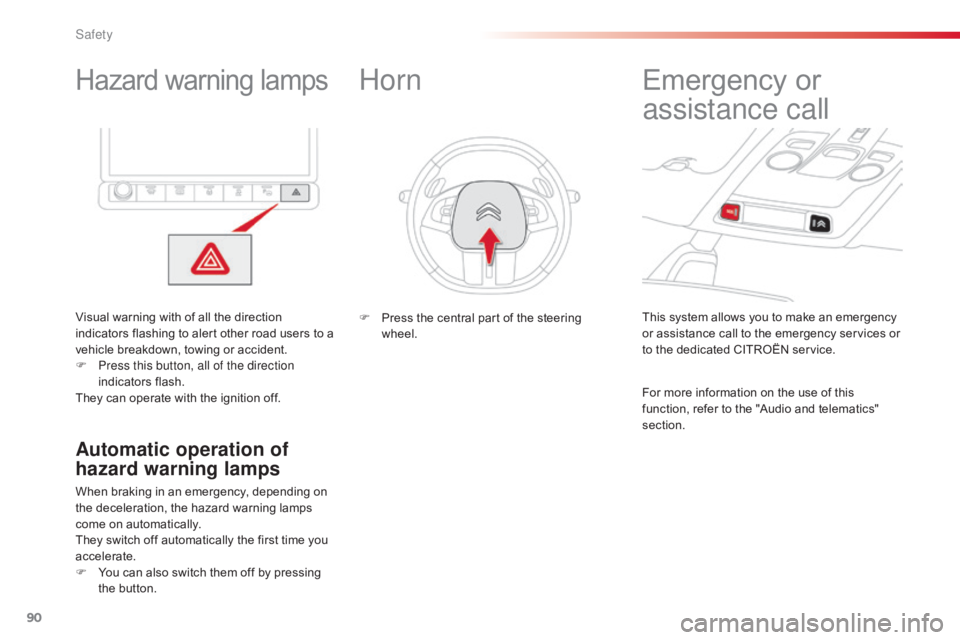
90
C4-cactus_en_Chap05_securite_ed01-2016
Hazard warning lamps
Visual warning with of all the direction i
ndicators flashing to alert other road users to a
v
ehicle breakdown, towing or accident.
F
P
ress this button, all of the direction
indicators
f
lash.
They
can operate with the ignition off.
Automatic operation of
hazard warning lamps
When braking in an emergency, depending on the deceleration, the hazard warning lamps
c
ome on automatically.
They
switch off automatically the first time you
a
ccelerate.
F
Y
ou can also switch them off by pressing
t
he button. This
system allows you to make an emergency
o
r assistance call to the emergency services or
t
o the dedicated CITROËN service.
Emergency o
r
a
ssistance call
For more information on the use of this f
unction, refer to the "Audio and telematics"
s
ection.
Horn
F Press the central part of the steering w
heel.
Safety
Page 93 of 317
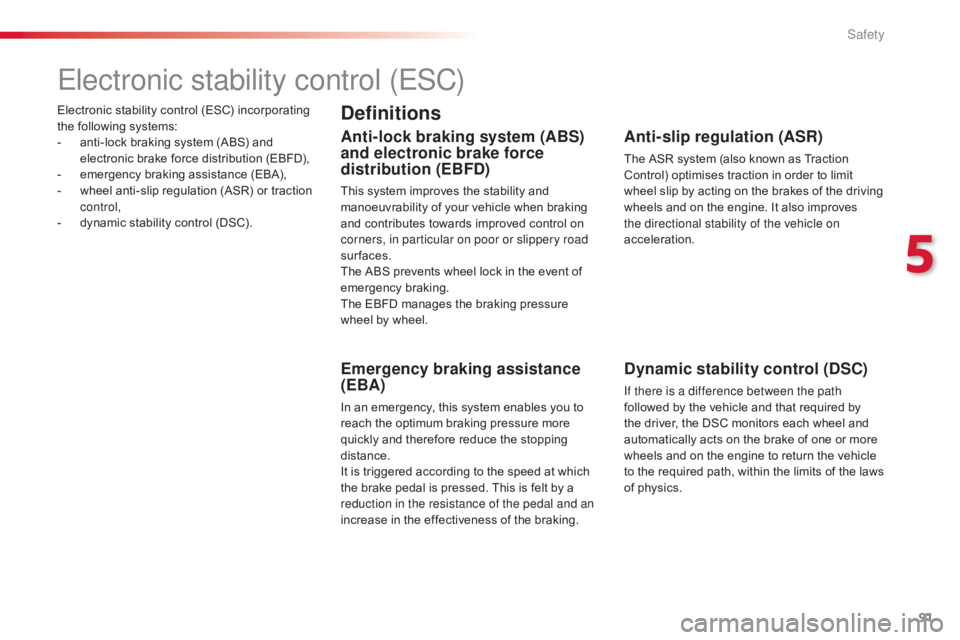
91
C4-cactus_en_Chap05_securite_ed01-2016
Electronic stability control (ESC) incorporating the following systems:
-
a
nti-lock braking system (ABS) and
e
lectronic brake force distribution (EBFD),
-
e
mergency braking assistance (EBA),
-
w
heel anti-slip regulation (ASR) or traction
c
ontrol,
-
d
ynamic stability control (DSC).
Electronic stability control (ESC)
Definitions
Anti-lock braking system (ABS)
and electronic brake force
distribution (EBFD)
This system improves the stability and manoeuvrability of your vehicle when braking
a
nd contributes towards improved control on
c
orners, in particular on poor or slippery road
surfaces.
The
ABS prevents wheel lock in the event of
em
ergency
b
raking.
The
EBFD manages the braking pressure
w
heel by wheel.
Emergency braking assistance
(EBA)
In an emergency, this system enables you to reach the optimum braking pressure more
q
uickly and therefore reduce the stopping
di
stance.
It
is triggered according to the speed at which
t
he brake pedal is pressed. This is felt by a
r
eduction in the resistance of the pedal and an
increase
in the effectiveness of the braking.
Anti-slip regulation (ASR)
The ASR system (also known as Traction Control) optimises traction in order to limit
w
heel slip by acting on the brakes of the driving
w
heels and on the engine. It also improves
t
he directional stability of the vehicle on
acceleration.
Dynamic stability control (DSC)
If there is a difference between the path
followed by the vehicle and that required by
t
he driver, the DSC monitors each wheel and
a
utomatically acts on the brake of one or more
w
heels and on the engine to return the vehicle
t
o the required path, within the limits of the laws
o
f physics.
5
Safety
Page 94 of 317
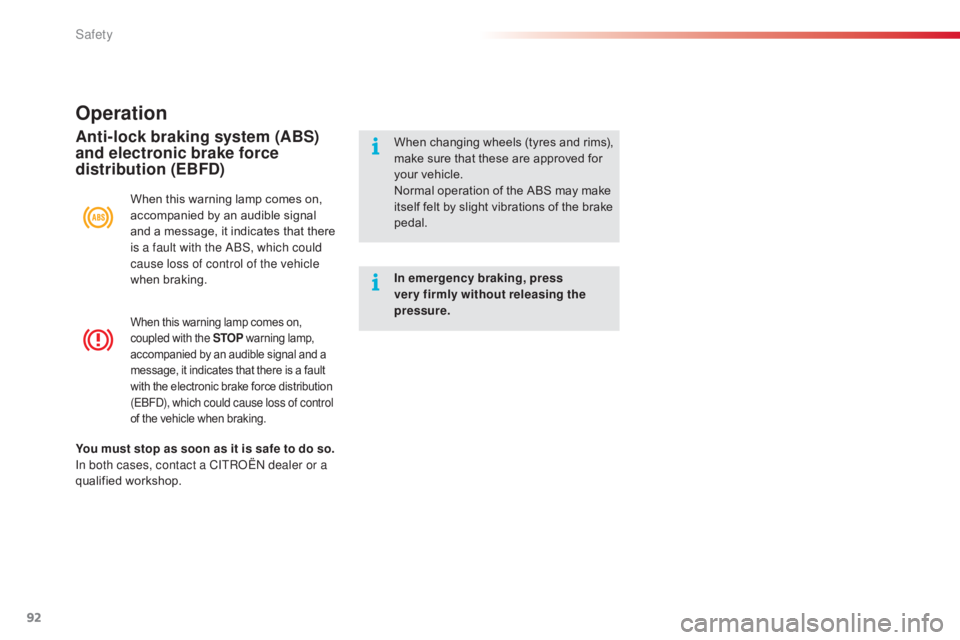
92
C4-cactus_en_Chap05_securite_ed01-2016
When this warning lamp comes on, coupled with the STOP w arning lam p, a
ccompanied by an audible signal and a
m
essage, it indicates that there is a fault
w
ith the electronic brake force distribution
(
EBFD), which could cause loss of control
of
the vehicle when braking.
Operation
When this warning lamp comes on, accompanied by an audible signal
a
nd a message, it indicates that there
i
s a fault with the ABS, which could
cause loss of control of the vehicle
when
b
raking.
Anti-lock braking system (ABS)
and electronic brake force
distribution (EBFD)When changing w heels ( tyres a nd r ims), m
ake sure that these are approved for
y
our vehicle.
Normal
operation of the ABS may make
i
tself felt by slight vibrations of the brake
ped
al.
In emergency braking, press
very firmly without releasing the
pressure.
You must stop as soon as it is safe to do so.
In both cases, contact a CITROËN dealer or a
qualified
w
orkshop.
Safety